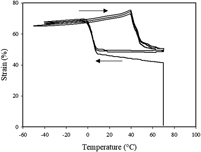Crossref Citations
This article has been cited by the following publications. This list is generated based on data provided by
Crossref.
Kuang, Wenbin
and
Mather, Patrick T.
2018.
Tuning of reversible actuation via ROMP-based copolymerization semicrystalline polymers.
Polymer,
Vol. 156,
Issue. ,
p.
228.
Koosomsuan, Wasin
Yamaguchi, Masayuki
Phinyocheep, Pranee
and
Sirisinha, Kalyanee
2019.
High‐Strain Shape Memory Behavior of PLA–PEG Multiblock Copolymers and Its Microstructural Origin.
Journal of Polymer Science Part B: Polymer Physics,
Vol. 57,
Issue. 5,
p.
241.
Zare, Mohadeseh
Parvin, Nader
Prabhakaran, Molamma P.
Mohandesi, Jamshid Aghazadeh
and
Ramakrishna, Seeram
2019.
Highly porous 3D sponge-like shape memory polymer for tissue engineering application with remote actuation potential.
Composites Science and Technology,
Vol. 184,
Issue. ,
p.
107874.
Mohamed, Salma Taher
Tirkes, Seha
Akar, Alinda Oyku
and
Tayfun, Umit
2020.
Hybrid nanocomposites of elastomeric polyurethane containing halloysite nanotubes and POSS nanoparticles: tensile, hardness, damping and abrasion performance.
Clay Minerals,
Vol. 55,
Issue. 4,
p.
281.
Dai, Zhuding
Jiang, Pingping
Lou, Wenxue
Zhang, Pingbo
Bao, Yanmin
Gao, Xuewen
Xia, Jialiang
and
Haryono, Agus
2020.
Preparation of degradable vegetable oil-based waterborne polyurethane with tunable mechanical and thermal properties.
European Polymer Journal,
Vol. 139,
Issue. ,
p.
109994.
2021.
Enzymatic Plastic Degradation.
Vol. 648,
Issue. ,
p.
317.
Anbarasan, Ramasamy
Meenarathi, Balakrishnan
Senthilkumar, Ponnusamy
and
Vellaichamy, Parthasarathy
2021.
Spectral, thermal and morphological studies of fluorescent dye grafted diblock copolymers.
Journal of Macromolecular Science, Part A,
Vol. 58,
Issue. 6,
p.
387.
Anokhin, Denis V.
Gorbunova, Marina A.
Abukaev, Ainur F.
and
Ivanov, Dimitri A.
2021.
Multiblock Thermoplastic Polyurethanes: In Situ Studies of Structural and Morphological Evolution under Strain.
Materials,
Vol. 14,
Issue. 11,
p.
3009.
Wei, Wanting
Liu, Junhao
Huang, Jian
Cao, Feng
Qian, Kun
Yao, Yongtao
and
Li, Wenbing
2022.
Recent advances and perspectives of shape memory polymer fibers.
European Polymer Journal,
Vol. 175,
Issue. ,
p.
111385.
Salaris, Valentina
Leonés, Adrián
Lopez, Daniel
Kenny, José Maria
and
Peponi, Laura
2022.
Shape-Memory Materials via Electrospinning: A Review.
Polymers,
Vol. 14,
Issue. 5,
p.
995.
Dong, Xinyu
Zhang, Fenghua
Wang, Linlin
Liu, Yanju
and
Leng, Jinsong
2022.
4D printing of electroactive shape-changing composite structures and their programmable behaviors.
Composites Part A: Applied Science and Manufacturing,
Vol. 157,
Issue. ,
p.
106925.
Liguori, Anna
Pandini, Stefano
Rinoldi, Chiara
Zaccheroni, Nelsi
Pierini, Filippo
Focarete, Maria Letizia
and
Gualandi, Chiara
2022.
Thermoactive Smart Electrospun Nanofibers.
Macromolecular Rapid Communications,
Vol. 43,
Issue. 5,
Wang, Lu
Zhang, Fenghua
Liu, Yanju
and
Leng, Jinsong
2022.
Shape Memory Polymer Fibers: Materials, Structures, and Applications.
Advanced Fiber Materials,
Vol. 4,
Issue. 1,
p.
5.
Wang, Xiaofei
He, Yang
and
Leng, Jinsong
2022.
Smart Shape Memory Polyurethane with Photochromism and Mechanochromism Properties.
Macromolecular Materials and Engineering,
Vol. 307,
Issue. 3,
Fitzgerald, Danielle M.
Colson, Yolonda L.
and
Grinstaff, Mark W.
2023.
Synthetic pressure sensitive adhesives for biomedical applications.
Progress in Polymer Science,
Vol. 142,
Issue. ,
p.
101692.
Tekay, Emre
and
Şen, Sinan
2023.
Investigation of shape memory and mechanical properties of styrenic thermoplastic elastomer/PCL blends: Effect of blend composition.
Journal of Materials Research,
Vol. 38,
Issue. 23,
p.
5065.
Liu, Haihui
Li, Guoting
Zhang, Jingguang
Sang, Ziheng
Chen, Ze
Xu, Qiang
Wang, Shuai
and
Zhang, Xingxiang
2024.
Synthesis and properties of temperature-responsive shape memory polyurethane with secondary crosslinked network structure based on LPO.
Polymer,
Vol. 311,
Issue. ,
p.
127559.
Hamidi, Muhammad Nafiz
Abdullah, Jamaluddin
Shuib, Raa Khimi
Aziz, Izhar
and
Namazi, Hamidreza
2024.
4D printing of polylactic acid (PLA)/thermoplastic polyurethane (TPU) shape memory polymer – a review.
Engineering Research Express,
Vol. 6,
Issue. 1,
p.
012402.
Norozi, Shima
Ghollasi, Mrazieh
Salimi, Ali
Halabian, Raheleh
and
Shahrousvad, Mohsen
2024.
Mesenchymal stem cells osteogenic differentiation by ZnO nanoparticles and polyurethane bimodal foam nanocomposites.
Cell and Tissue Banking,
Vol. 25,
Issue. 1,
p.
167.
Beycan, Burhan
Kalkan Erdoğan, Meryem
Sancak, Erhan
Karakışla, Meral
and
Saçak, Mehmet
2024.
Creating Safe, Biodegradable Nanofibers for Food Protection: A Look into Waterborne Polyurethane Electrospinning.
Industrial & Engineering Chemistry Research,
Vol. 63,
Issue. 33,
p.
14495.


